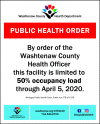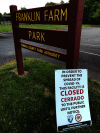COVID-19, the Built Environment, and Health
- PMID: 34288733
- PMCID: PMC8294798
- DOI: 10.1289/EHP8888
COVID-19, the Built Environment, and Health
Abstract
Background: Since the dawn of cities, the built environment has both affected infectious disease transmission and evolved in response to infectious diseases. COVID-19 illustrates both dynamics. The pandemic presented an opportunity to implement health promotion and disease prevention strategies in numerous elements of the built environment.
Objectives: This commentary aims to identify features of the built environment that affect the risk of COVID-19 as well as to identify elements of the pandemic response with implications for the built environment (and, therefore, for long-term public health).
Discussion: Built environment risk factors for COVID-19 transmission include crowding, poverty, and racism (as they manifest in housing and neighborhood features), poor indoor air circulation, and ambient air pollution. Potential long-term implications of COVID-19 for the built environment include changes in building design, increased teleworking, reconfigured streets, changing modes of travel, provision of parks and greenspace, and population shifts out of urban centers. Although it is too early to predict with confidence which of these responses may persist, identifying and monitoring them can help health professionals, architects, urban planners, and decision makers, as well as members of the public, optimize healthy built environments during and after recovery from the pandemic. https://doi.org/10.1289/EHP8888.
Figures








Comment in
-
Comment on "COVID-19, the Built Environment, and Health".Environ Health Perspect. 2021 Sep;129(9):98001. doi: 10.1289/EHP10144. Epub 2021 Sep 14. Environ Health Perspect. 2021. PMID: 34519536 Free PMC article. No abstract available.
Similar articles
-
Built Environment, Transport, and COVID-19: a Review.Curr Environ Health Rep. 2021 Jun;8(2):138-145. doi: 10.1007/s40572-021-00307-7. Epub 2021 Mar 5. Curr Environ Health Rep. 2021. PMID: 33666869 Free PMC article. Review.
-
Using 164 Million Google Street View Images to Derive Built Environment Predictors of COVID-19 Cases.Int J Environ Res Public Health. 2020 Sep 1;17(17):6359. doi: 10.3390/ijerph17176359. Int J Environ Res Public Health. 2020. PMID: 32882867 Free PMC article.
-
Exposome-based public health interventions for infectious diseases in urban settings.Environ Int. 2021 Jan;146:106246. doi: 10.1016/j.envint.2020.106246. Epub 2020 Nov 9. Environ Int. 2021. PMID: 33181410 Free PMC article. Review.
-
Leveraging built environment interventions to equitably promote health during and after COVID-19 in Toronto, Canada.Health Promot Int. 2022 Apr 29;37(2):daab128. doi: 10.1093/heapro/daab128. Health Promot Int. 2022. PMID: 34423362 Free PMC article.
-
Supporting Local Public Health and Planning Professionals to Implement Built Environment Changes: A Technical Assistance Program to Promote Physical Activity in Texas.Prev Chronic Dis. 2024 Jun 20;21:E45. doi: 10.5888/pcd21.230420. Prev Chronic Dis. 2024. PMID: 38900694 Free PMC article.
Cited by
-
A city-level transport vision for 2050: Reimagined since COVID-19.Transp Policy (Oxf). 2023 Mar;132:144-153. doi: 10.1016/j.tranpol.2022.12.022. Epub 2023 Jan 2. Transp Policy (Oxf). 2023. PMID: 36618963 Free PMC article.
-
Associations Between Built Environment Factors and SARS-CoV-2 Infections at the Neighbourhood Level in a Metropolitan Area in Germany.J Urban Health. 2023 Feb;100(1):40-50. doi: 10.1007/s11524-022-00708-5. Epub 2023 Jan 12. J Urban Health. 2023. PMID: 36635521 Free PMC article.
-
The COVID-19 pandemic, an environmental neurology perspective.Rev Neurol (Paris). 2022 Jun;178(6):499-511. doi: 10.1016/j.neurol.2022.02.455. Epub 2022 Mar 22. Rev Neurol (Paris). 2022. PMID: 35568518 Free PMC article. Review.
-
The effects of COVID-19 on African American communities in Baltimore's health enterprise zones: a mixed-methods examination.BMC Public Health. 2023 Sep 27;23(1):1873. doi: 10.1186/s12889-023-16782-6. BMC Public Health. 2023. PMID: 37759208 Free PMC article.
-
COVID-19-related adolescent mortality and morbidity in nineteen European countries.Eur J Pediatr. 2023 Sep;182(9):3997-4005. doi: 10.1007/s00431-023-05068-z. Epub 2023 Jun 29. Eur J Pediatr. 2023. PMID: 37382673 Free PMC article.
References
-
- Abolanle RG, Alexandra MC-C, Paul AS, Malcolm HG. 2020. The contribution of commuting to total daily moderate-to-vigorous physical activity. J Meas Phys Behav 3(3):189–196, 10.1123/jmpb.2019-0027. - DOI
-
- Acuto M. 2020. Will COVID-19 make us think of cities differently? NewCities. 20 March 2020. https://newcities.org/the-big-picture-will-covid-19-make-us-think-cities... [accessed 11 July 2021].
-
- Adhikari S, Pantaleo NP, Feldman JM, Ogedegbe O, Thorpe L, Troxel AB. 2020. Assessment of community-level disparities in coronavirus disease 2019 (COVID-19) infections and deaths in large US metropolitan areas. JAMA Netw Open 3(7):e2016938, PMID: 3272102, 10.1001/jamanetworkopen.2020.16938. - DOI - PMC - PubMed
-
- Aegerter AM, Deforth M, Johnston V, Sjøgaard G, Volken T, Luomajoki H, et al. . 2021. No evidence for an effect of working from home on neck pain and neck disability among Swiss office workers: short-term impact of COVID-19. Eur Spine J Apr:1–9, PMID: 33817763, 10.1007/s00586-021-06829-w. - DOI - PMC - PubMed
MeSH terms
LinkOut - more resources
Full Text Sources
Medical

